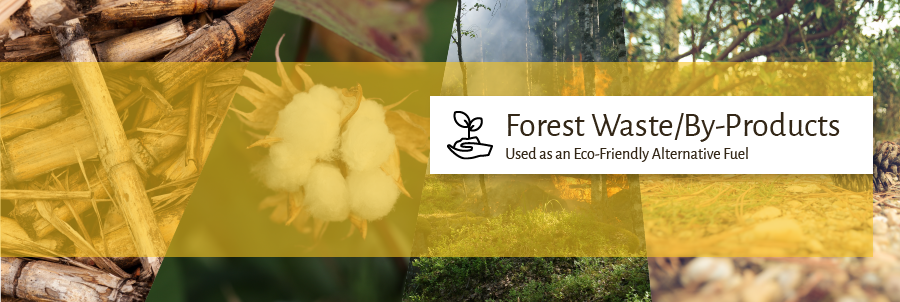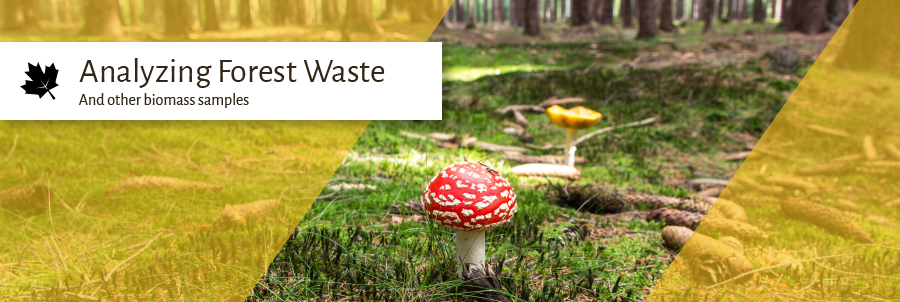
USING FOREST WASTE AS AN ALTERNATIVE FUEL
Analyzing Forest Waste / Forest By-Products as an Alternative Fuel
WHY ANALYZE FOREST WASTE?
Solid biomass fuels are useful and a cost effective renewable energy source. The energy content of the biomass is determined by its calorific value. The calorific value of different forest species and bio-based industry residues can be used by companies specializing in processing raw biomass solid bio fuel production, small-scale consumers. Samples like populous, fagus and pinus can be burned in an oxygen bomb calorimeter and analyzed for its calorific value.
Biomass is a biological material derived from living organisms (plants and animals). Often it refers to plant based materials. Biomass includes wastes and residues from agro forestry and related bio-based industries, as well as plantation biomass (energy crops). Agricultural residues include stalks, leaves, roots, husks, nuts and seed shells. Energy crops include trees grown through traditional agricultural practices (including eucalyptus, poplar, oil palm). Wood wastes and forestry residues include wood chips, bark, sawdust, timber slash, and mill scrap. Examples of bio-based industry wastes that have potential for biomass production are pulp sludge, fruit pits, alcohol fermentation stillage, and other organic wastes.
Fuels made from biomass are useful and a cost effective energy source widely used in developing countries, in some cases the primary energy consumption. Solid biomass fuels have advantages over fossil fuels due to environmental aspects. The disadvantage of using agricultural residues is crop seasonality that creates an unsteady and unreliable biomass supply. The processing of biomass materials to pellets or briquettes makes transportation more efficient.
The energy contained in forest residues due to deforestation, woodland clearing and firebreaks is very high and end up being wasted. These residues can be used as a renewable energy source.
Among the uses of biomass the wood pellet is also included. New techniques are available to turn wood and crop residues into standardized pellets that are environmentally safe and easy to handle. These pellets can be used in domestic wood-burning appliances which include fireplaces, pellet stoves and burners, central heating furnaces and boilers.
The utilization of wood and crop residues as an energy source will serve to reduce consumption of fossil fuels, thereby reducing the emission of greenhouse gases to the environment. Ideal for providing fuel for heating devices, the pellets created from wood residues and forest waste is pure, non pollutant, and neutral in carbon dioxide emissions.

TYPES OF FOREST WASTE / BIOMASS
- Biomass samples like rice husks, apricot kernels, olive pits, sunflower husks, and cotton stems are collected.
- Energy crops and wetland herbs can also be used : cardoon, switchgrass, common reed, and narrow-leaf cattail)
- Forest residues : Populus, Fagus and Pinus).
- Cotton is primarily an agricultural crop, but can also be found growing in the wild.

METHOD FOR ANALYZING FOREST WASTE
The calorific value of biomass and forest waste can be determined using an oxygen bomb calorimeter. Samples are dried in a natural convection stove to determine the moisture content, and then processed using a cutting mill to pelletize the sample. In the production of fuel pellets and briquettes, the feedstock has to be milled, pulped and steamed before being transformed into a denser product. It is a pure powder form refined from wood or crop residues that has been put under high pressure so as to be formed into small cylinders of various sizes. Given the pressure and its reduced humidity, the energetic density of the wood/waste pellet is approximately double than that of the wood. Size reduction is an important treatment of biomass for energy conversion.
An oxygen bomb calorimeter is then used to determine the calorific value of the different agroforestry species and bio-based industry residues. The oxygen bomb calorimeter is the most prevalent technique of measuring calorific value in a laboratory and in industrial environments. The principle operation of the calorimeter is based on measuring the heat released from the complete combustion of a fuel in an oxygen environment.
- The oxygen bomb calorimeter is calibrated and verified using a Benzoic Acid Tablet
- The biomass sample is weighed on a precision balance.
- The powdered sample is inserted into a gelatine capsule or pressed into a compact material.
- The cotton thread and firing wire are attached to the lid assembly.
- The capsule and crucible is carefully placed into the bomb vessel.
- Ensure the firing cotton lies on top of the capsule
- The bomb vessel is closed and filled with oxygen before it’s placed into the bomb calorimeter
- The bomb calorimeter lid is then closed and the determination is started
The DDS Calorimeters range of oxygen bomb calorimeters automatically makes all the necessary calculations to produce the gross calorific value of the biomass sample.
CONCLUSION
The energy content of biomass is determined by its calorific value. The calorific value is influenced by biomass elemental composition, moisture and ash content. The gross calorific value of different agroforestry species and bio-based industry residues can range anywhere from 14.3 to 25.4 MJ/Kg. The energy differences are mainly due to different carbon content (main energy source), moisture content, ash content (no combustible material) or the experimental site.
Studies have shown that the energy analysis in crop plants and wetland herbs show that significant differences exist in calorific energy distribution on different plant organs. Root and main stems have the same calorific energy values. The lowest calorific energy value in all plant organs is the leaves. Also seeds, kernels and flowers have the highest energy values due to higher lipid content.
It was also found that rice husk and rice straw have a high ash content. Silica is the major composition of rice husk ash. With such a large ash content and silica in the ash it becomes economical to extract silica from the ash.
Biomass from forest residue, who higher gross calorific values in comparison with biomass from agricultural crop and wetland herbs.
(References: http://file.scirp.org/pdf/NR_2016012216040930.pdf)

